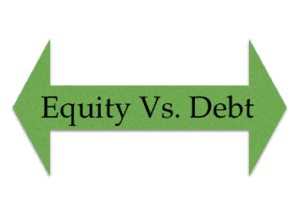There is a lot of media focus on crowdfunding, but sometimes the types of crowdfunding are not properly distinguished. You hear a lot about the Kickstarter’s and Indiegogo’s of the world and people are confusing these with actual investments in companies. To understand debt (lending) vs. equity based crowdfunding you must first know the four basic types of crowdfunding:
- Donations based crowdfunding is being used by major charities and by individuals who are asking for donations to their cause. Examples of these types of portals include: GoFundMe, Crowdrise.com
 Rewards based crowdfunding is one the most popular and widely used versions to date. This is where individuals and companies are seeking contributions in order to develop and launch a new product. These have been very successful with films and new technology or products ideas that need funding to launch. It needs to be clarified that under rewards based campaigns the contributors do not receive shares in any of the companies, but rather receive some reward (such as a version of the new product once developed, a T-shirt or trinket, a DVD version of a film, etc.). Examples of these types of portals include: Kickstarter, Indiegogo
Rewards based crowdfunding is one the most popular and widely used versions to date. This is where individuals and companies are seeking contributions in order to develop and launch a new product. These have been very successful with films and new technology or products ideas that need funding to launch. It needs to be clarified that under rewards based campaigns the contributors do not receive shares in any of the companies, but rather receive some reward (such as a version of the new product once developed, a T-shirt or trinket, a DVD version of a film, etc.). Examples of these types of portals include: Kickstarter, Indiegogo- Equity based crowdfunding has been getting more and more attention over the last year with the JOBS Act in the U.S.A. and other regulators around the world releasing regulations to allow equity (and debt) crowdfunding. Under these regulations some serious funds have been raised to date and this is expected to grow rapidly over the next few years. In equity crowdfunding companies raise money through investors who receive shares in the company in exchange. Examples of such portals include: OfferBoard, CircleUp, OurCrowd, ASSOB.com.au, AppVested, I-Bankers.com, CrowdCube, Symbid, Crowdfunder.com, EnergyFunders, KlondikeStrike
- Debt based crowdfunding is where lenders are able to provide needed debt financing and the lender receives a debt instrument that pays interest return. Examples of these types of portals include: Prosper, Funding Circle, LendingClub
 So what is the difference between equity and debt crowdfunding and why is there confusion? The biggest confusion is over the types of crowdfunding as briefly explained above. Even the media has confused these in the past. Generally people lump debt and equity crowdfunding into one category and call them both equity crowdfunding. They are lumped together because both equity and debt crowdfunding are regulated in much the same way, whereas donations and rewards are unregulated.
So what is the difference between equity and debt crowdfunding and why is there confusion? The biggest confusion is over the types of crowdfunding as briefly explained above. Even the media has confused these in the past. Generally people lump debt and equity crowdfunding into one category and call them both equity crowdfunding. They are lumped together because both equity and debt crowdfunding are regulated in much the same way, whereas donations and rewards are unregulated.
Regulators around the world have had rules to regulate the sale of securities for a long time. Since both equity and debt financing fall under the term security, they must be regulated to protect the public from fraud and scams. This is why equity and debt crowdfunding has taken longer to be released around the world as regulators have had to revise their local securities regulations and corporate legislation to allow securities to be crowdfunded.
As an investor in equity or debt crowdfunding you are investing in a security of the company. With equity you are receiving shares for your investment in hopes that the company will pay you a dividend on your shares out of the company’s profits, or you are expecting the company to grow to a point where you will eventually be able to sell your shares at a higher price then you paid for them.
 In debt crowdfunding you are also investing in a security of the company (namely a debt instrument of some type) where your goal is to loan your money to the company with a fixed repayment term and the company pays you a specified interest rate during the term of the loan.
In debt crowdfunding you are also investing in a security of the company (namely a debt instrument of some type) where your goal is to loan your money to the company with a fixed repayment term and the company pays you a specified interest rate during the term of the loan.
There are a variety of types of debt instruments that are available to investors. Some allow for conversion into common shares so that investors have the potential upside growth in the company while they receive steady interest payments, while others are straight interest yielding securities. There are secured and unsecured debt instruments. All of these factors plus the risk associated with the invest influence the interest rate and conversion rights (if any).
 Debt crowdfunding is very attractive for those investors who desire a fixed return, making it easier for financial planning purposes. Traditionally debt investments that are secured against the company assets are seen as less risky and hence provide a lower interest rate yield than the unsecured instruments.
Debt crowdfunding is very attractive for those investors who desire a fixed return, making it easier for financial planning purposes. Traditionally debt investments that are secured against the company assets are seen as less risky and hence provide a lower interest rate yield than the unsecured instruments.
It should be noted that even though debt investments has are perceived to be lower risk, the portals will still be required to do the same level of due diligence as they would for equity type investments. They will also have to assess the company’s ability to meet the repayment schedule to the investors.
When you have a better understanding of the types of crowdfunding available then you can assess what investments help you meet your investment objectives. If you need help further assistance in assessing what type of investments best suit your particular circumstance it is best to contact a professional for advice.
__________________
 Jason Futko, CA, CPA, is the CFO of BoardSuite a leading Crowdfunding Infrastructure Platform (CFIP. Jason is also the co-founder, executive council member of the Equity Crowdfunding Alliance of Canada. Jason currently sits as Chairman of the Board and is acting President for Phoenician Corporation IV Limited. Phoenician IV is listed on the ICAP Securities & Derivatives Exchange in London, UK. He is also a Director of Brook Capital Corporation in Toronto, an Exempt Market Dealer.
Jason Futko, CA, CPA, is the CFO of BoardSuite a leading Crowdfunding Infrastructure Platform (CFIP. Jason is also the co-founder, executive council member of the Equity Crowdfunding Alliance of Canada. Jason currently sits as Chairman of the Board and is acting President for Phoenician Corporation IV Limited. Phoenician IV is listed on the ICAP Securities & Derivatives Exchange in London, UK. He is also a Director of Brook Capital Corporation in Toronto, an Exempt Market Dealer.

